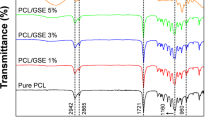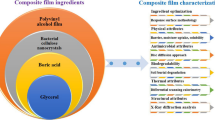Abstract
From an academic standpoint, scientists all around the globe have been paying close attention to the use of inexpensive, naturally occurring polymers. Given this consideration, the research aimed to integrate hydroxyethyl cellulose (HEC) and polyacrylic acid (PA), to produce biodegradable films for food packaging. Different concentrations of pomegranate peel (PoP) extract were incorporated into the film solutions to augment the antimicrobial effectiveness of these films. As a result, four film products were obtained by incorporating four different concentrations (2, 4, 6, and 8 mL) of PoP extract into the HEC/PA film matrix. These films were coded as PoP-1@HEC/PA film, PoP-2@HEC/PA film, PoP-3@HEC/PA film, and PoP-4@HEC/PA film, which were compared to the film without PoP extract (HEC/PA film). The film products were characterized, and the data confirmed the deposition of PoP extract onto the surface of the HEC/PA film. The water contact angle of HEC/PA film was initially measured as 77.3°, which decreased to 71.4° with the addition of PoP extract (PoP-4@HEC/PA film). These values remained above the threshold of 20°, indicating their suitability for food packaging and preservation. Furthermore, the water vapor transmission rate (WVTR) of PoP-4@HEC/PA film was lower compared to HEC/PA film. The surface area covered by the deposited PoP extract particles increased with the higher concentrations of the extract in the polymer films. Biodegradability evaluations demonstrated that PoP extract enhanced the degradation of the HEC and PA polymer films over time. Contact angle assessments also indicated the hydrophobic nature of the resulting films, with contact angles exceeding 60°. Antimicrobial studies were conducted on the PoP extract against four different foodborne species. The results revealed strong microstatic effects of PoP extract against the targeted microbes. The susceptibility of various bacterial strains to PoP extracts varied, with the methanolic PoP extract producing inhibitory zones of 30.3, 25.3, 22.6, and 18 mm against Escherichia coli, Staphylococcus aureus, Candida albicans, and Aspergillus niger, respectively, in the disc diffusion assay. The antibacterial evaluation was further performed by incorporating different concentrations of PoP extract into the HEC/PA film. The results demonstrated that PoP-3@HEC/PA and PoP-4@HEC/PA films exhibited the highest inhibitory effects. Notably, complete reduction of bacteria was achieved after exposure to PoP-4@HEC/PA film. Based on the promising findings, the developed biodegradable films hold potential for eco-friendly food packaging, as they can extend the shelf life of packaged food products.












Similar content being viewed by others
Data availability
All the datasets used and/or analyzed in this study are available in the manuscript, and supplementary information can be requested from the corresponding author.
References
Xie Y-Y, Hu X-H, Zhang Y-W et al (2020) Development and antibacterial activities of bacterial cellulose/graphene oxide-CuO nanocomposite films. Carbohydr Polym 229:115456. https://doi.org/10.1016/j.carbpol.2019.115456
Moshood TD, Nawanir G, Mahmud F et al (2022) Sustainability of biodegradable plastics: new problem or solution to solve the global plastic pollution? Curr Res Green Sustain Chem 5:100273. https://doi.org/10.1016/j.crgsc.2022.100273
Sirviö JA, Honkaniemi S, Visanko M, Liimatainen H (2015) Composite films of poly(vinyl alcohol) and bifunctional cross-linking cellulose nanocrystals. ACS Appl Mater Interfaces 7:19691–19699. https://doi.org/10.1021/acsami.5b04879
Kritchenkov AS, Egorov AR, Kurasova MN et al (2019) Novel non-toxic high efficient antibacterial azido chitosan derivatives with potential application in food coatings. Food Chem 301:125247. https://doi.org/10.1016/j.foodchem.2019.125247
Zhu H, Cheng J-H, Han Z, Han Z (2021) Cold plasma enhanced natural edible materials for future food packaging: structure and property of polysaccharides and proteins-based films. Crit Rev Food Sci Nutr:1–17. https://doi.org/10.1080/10408398.2021.2002258
Mehta MJ, Kumar A (2019) Ionic liquid assisted gelatin films: green, UV shielding, antioxidant, and antibacterial food packaging materials. ACS Sustain Chem Eng 7:8631–8636. https://doi.org/10.1021/acssuschemeng.9b00423
Khosravi A, Fereidoon A, Khorasani MM et al (2020) Soft and hard sections from cellulose-reinforced poly(lactic acid)-based food packaging films: a critical review. Food Packag Shelf Life 23:100429. https://doi.org/10.1016/j.fpsl.2019.100429
Gutiérrez-Del-Río I, Fernández J, Lombó F (2018) Plant nutraceuticals as antimicrobial agents in food preservation: terpenoids, polyphenols and thiols. Int J Antimicrob Agents 52:309–315. https://doi.org/10.1016/j.ijantimicag.2018.04.024
Carocho M, Barreiro MF, Morales P, Ferreira ICFR (2014) Adding molecules to food, pros and cons: a review on synthetic and natural food additives. Compr Rev food Sci Food Saf 13:377–399
D’Amore T, Di Taranto A, Berardi G et al (2020) Sulfites in meat: occurrence, activity, toxicity, regulation, and detection. A comprehensive review. Compr Rev Food Sci Food Saf 19:2701–2720
Singh B, Singh JP, Kaur A, Singh N (2019) Antimicrobial potential of pomegranate peel: a review. Int J Food Sci Technol 54:959–965. https://doi.org/10.1111/ijfs.13964
Ambigaipalan P, de Camargo AC, Shahidi F (2016) Phenolic compounds of pomegranate byproducts (outer skin, mesocarp, divider membrane) and their antioxidant activities. J Agric Food Chem 64:6584–6604. https://doi.org/10.1021/acs.jafc.6b02950
Fawole OA, Makunga NP, Opara UL (2012) Antibacterial, antioxidant and tyrosinase-inhibition activities of pomegranate fruit peel methanolic extract. BMC Complement Altern Med 12:200. https://doi.org/10.1186/1472-6882-12-200
Sorrenti V, Randazzo CL, Caggia C et al (2019) Beneficial effects of pomegranate peel extract and probiotics on pre-adipocyte differentiation. Front Microbiol 3(10):660. https://doi.org/10.3389/fmicb.2019.00660
Vilela C, Pinto RJB, Coelho J et al (2017) Bioactive chitosan/ellagic acid films with UV-light protection for active food packaging. Food Hydrocoll 73:120–128. https://doi.org/10.1016/j.foodhyd.2017.06.037
Liu Y, Ma Y, Liu Y et al (2022) Fabrication and characterization of pH-responsive intelligent films based on carboxymethyl cellulose and gelatin/curcumin/chitosan hybrid microcapsules for pork quality monitoring. Food Hydrocoll 124:107224. https://doi.org/10.1016/j.foodhyd.2021.107224
Arkaban H, Barani M, Akbarizadeh MR et al (2022) Polyacrylic acid nanoplatforms: antimicrobial, tissue engineering, and cancer theranostic applications. Polymers (Basel) 14. https://doi.org/10.3390/polym14061259
Abdelhedi O, Nasri R, Jridi M et al (2018) Composite bioactive films based on smooth-hound viscera proteins and gelatin: physicochemical characterization and antioxidant properties. Food Hydrocoll 74:176–186. https://doi.org/10.1016/j.foodhyd.2017.08.006
Hanani ZAN, Yee FC, Nor-Khaizura MAR (2019) Effect of pomegranate (Punica granatum L.) peel powder on the antioxidant and antimicrobial properties of fish gelatin films as active packaging. Food Hydrocoll 89:253–259. https://doi.org/10.1016/j.foodhyd.2018.10.007
Moghadam M, Salami M, Mohammadian M et al (2020) Development of antioxidant edible films based on mung bean protein enriched with pomegranate peel. Food Hydrocoll 104:105735. https://doi.org/10.1016/j.foodhyd.2020.105735
Cui H, Surendhiran D, Li C, Lin L (2020) Biodegradable zein active film containing chitosan nanoparticle encapsulated with pomegranate peel extract for food packaging. Food Packag Shelf Life 24:100511. https://doi.org/10.1016/j.fpsl.2020.100511
He L, Lan W, Ahmed S et al (2019) Electrospun polyvinyl alcohol film containing pomegranate peel extract and sodium dehydroacetate for use as food packaging. Food Packag Shelf Life 22:100390. https://doi.org/10.1016/j.fpsl.2019.100390
Malviya S, Arvind JA, Hettiarachchy N (2014) Antioxidant and antibacterial potential of pomegranate peel extracts. J Food Sci Technol 51:4132–4137. https://doi.org/10.1007/s13197-013-0956-4
Gómez-Caravaca AM, Verardo V, Toselli M et al (2013) Determination of the major phenolic compounds in pomegranate juices by HPLC–DAD–ESI-MS. J Agric Food Chem 61:5328–5337. https://doi.org/10.1021/jf400684n
Yassin MT, Mostafa AA-F, Al Askar AA (2021) In vitro evaluation of biological activities and phytochemical analysis of different solvent extracts of Punica granatum L. (pomegranate) peels. Plants (Basel, Switzerland) 10. https://doi.org/10.3390/plants10122742
Derakhshan Z, Ferrante M, Tadi M et al (2018) Antioxidant activity and total phenolic content of ethanolic extract of pomegranate peels, juice and seeds. Food Chem Toxicol 114:108–111. https://doi.org/10.1016/j.fct.2018.02.023
Gonelimali FD, Lin J, Miao W et al (2018) Antimicrobial properties and mechanism of action of some plant extracts against food pathogens and spoilage microorganisms. Front Microbiol 9:1639. https://doi.org/10.3389/fmicb.2018.01639
Pandian CJ, Palanivel R, Dhanasekaran S (2016) Screening antimicrobial activity of nickel nanoparticles synthesized using Ocimum sanctum leaf extract. J Nanopart 2016(1):13. https://doi.org/10.1155/2016/4694367
Wang H, Wei D, Zheng A, Xiao H (2015) Soil burial biodegradation of antimicrobial biodegradable PBAT films. Polym Degrad Stab 116:14–22
Liu M, Huang Z, Yang Y-J (2010) Analysis of biodegradability of three biodegradable mulching films. J Polym Environ 18:148–154
Lavrič G, Oberlintner A, Filipova I et al (2021) Functional nanocellulose, alginate and chitosan nanocomposites designed as active film packaging materials. Polymers (Basel) 13:2523
Gennadios A, Weller CL, Gooding CH (1994) Measurement errors in water vapor permeability of highly permeable, hydrophilic edible films. J Food Eng 21:395–409
Kumar N, Daniloski D, Pratibha et al (2022) Pomegranate peel extract – a natural bioactive addition to novel active edible packaging. Food Res Int 156:111378. https://doi.org/10.1016/j.foodres.2022.111378
Singh B, Singh JP, Kaur A, Singh N (2018) Phenolic compounds as beneficial phytochemicals in pomegranate (Punica granatum L.) peel: a review. Food Chem 261:75–86. https://doi.org/10.1016/j.foodchem.2018.04.039
Kruk J, Aboul-Enein BH, Duchnik E, Marchlewicz M (2022) Antioxidative properties of phenolic compounds and their effect on oxidative stress induced by severe physical exercise. J Physiol Sci 72:19. https://doi.org/10.1186/s12576-022-00845-1
El-Hadary AE, Taha M (2020) Pomegranate peel methanolic-extract improves the shelf-life of edible-oils under accelerated oxidation conditions. Food Sci Nutr 8:1798–1811. https://doi.org/10.1002/fsn3.1391
Abdollahzadeh S, Mashouf R, Mortazavi H et al (2011) Antibacterial and antifungal activities of Punica granatum peel extracts against oral pathogens. J Dent (Tehran) 8:1–6
Al-Zoreky NS (2009) Antimicrobial activity of pomegranate (Punica granatum L.) fruit peels. Int J Food Microbiol 134:244–248. https://doi.org/10.1016/j.ijfoodmicro.2009.07.002
Navarro-Pérez ML, Fernández-Calderón MC, Vadillo-Rodríguez V (2022) Decomposition of growth curves into growth rate and acceleration: a novel procedure to monitor bacterial growth and the time-dependent effect of antimicrobials. Appl Environ Microbiol 88:e0184921. https://doi.org/10.1128/AEM.01849-21
Xie Y, He Y, Irwin PL et al (2011) Antibacterial activity and mechanism of action of zinc oxide nanoparticles against Campylobacter jejuni. Appl Environ Microbiol. https://doi.org/10.1128/AEM.02149-10
Vollmer W, Blanot D, De Pedro MA (2008) Peptidoglycan structure and architecture. FEMS Microbiol Rev 32:149–167. https://doi.org/10.1111/j.1574-6976.2007.00094.x
Elshafie HS, Caputo L, De Martino L et al (2021) Study of bio-pharmaceutical and antimicrobial properties of pomegranate (Punica granatum L.) leathery exocarp extract. Plants (Basel, Switzerland) 10. https://doi.org/10.3390/plants10010153
Hanafy SM, Abd El-Shafea YM, Saleh WD, Fathy HM (2021) Chemical profiling, in vitro antimicrobial and antioxidant activities of pomegranate, orange and banana peel-extracts against pathogenic microorganisms. J Genet Eng Biotechnol 19:80. https://doi.org/10.1186/s43141-021-00151-0
Arruda TR, Bernardes PC, e Moraes ARF, Soares NDFF (2022) Natural bioactives in perspective: the future of active packaging based on essential oils and plant extracts themselves and those complexed by cyclodextrins. Food Res Int 156:111160. https://doi.org/10.1016/j.foodres.2022.111160
Pinto L, Tapia-Rodríguez MR, Baruzzi F, Ayala-Zavala JF (2023) Plant antimicrobials for food quality and safety: recent views and future challenges. Foods 12(12):2315. https://doi.org/10.3390/foods12122315
Emam-Djomeh Z, Moghaddam A, Yasini Ardakani SA (2015) Antimicrobial activity of pomegranate (Punica granatum L.) peel extract, physical, mechanical, barrier and antimicrobial properties of pomegranate peel extract-incorporated sodium caseinate film and application in packaging for ground beef. Packag Technol Sci 28:869–881. https://doi.org/10.1002/pts.2145
Mushtaq M, Gani A, Gani A et al (2018) Use of pomegranate peel extract incorporated zein film with improved properties for prolonged shelf life of fresh Himalayan cheese (Kalari/kradi). Innov Food Sci Emerg Technol 48:25–32. https://doi.org/10.1016/j.ifset.2018.04.020
Butnaru E, Stoleru E, Brebu MA et al (2019) Chitosan-based bionanocomposite films prepared by emulsion technique for food preservation. Materials 12. https://doi.org/10.3390/ma12030373
Kumar S, Mukherjee A, Dutta J (2020) Chitosan based nanocomposite films and coatings: emerging antimicrobial food packaging alternatives. Trends Food Sci Technol 97:196–209. https://doi.org/10.1016/j.tifs.2020.01.002
Author information
Authors and Affiliations
Corresponding author
Ethics declarations
Ethics approval
Not applicable.
Competing interests
The author declares no competing interests.
Additional information
Publisher’s Note
Springer Nature remains neutral with regard to jurisdictional claims in published maps and institutional affiliations.
Supplementary information
ESM 1
(DOCX 82 kb)
Rights and permissions
Springer Nature or its licensor (e.g. a society or other partner) holds exclusive rights to this article under a publishing agreement with the author(s) or other rightsholder(s); author self-archiving of the accepted manuscript version of this article is solely governed by the terms of such publishing agreement and applicable law.
About this article
Cite this article
Farouk, A. Development and characterization of biodegradable hydroxyethyl cellulose/polyacrylic acid films loaded with pomegranate peel extract with antibacterial activity. Biomass Conv. Bioref. (2023). https://doi.org/10.1007/s13399-023-04892-5
Received:
Revised:
Accepted:
Published:
DOI: https://doi.org/10.1007/s13399-023-04892-5




